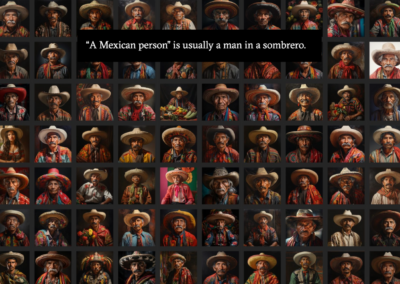“Are you sure you used the latest data to make your recommendation?” your colleague asks you, subtly implying that you haven’t done your homework. “We all use a shared drive with the latest reports,” she says, gesturing to other co-workers around the table, “but I guess we might have forgotten to give you access.”
Many of us have dealt with exclusionary behavior at the office — whether it’s colleagues who form cliques or a boss who openly prefers a chosen successor at the expense of others. But there are also plenty of people in positions of power whose backgrounds mean they’ll never experience anything like this — until they put on a virtual reality (VR) headset.
Last year, my company was working on a piece to try to help those leaders understand workplace exclusion. As we wrapped the final day of user testing, we had one more participant — a middle-aged white man who was a manager at his family business. He came in skeptical of the technology, and I cringed, reminding myself that our other testers had been positive and given good feedback. He put on the headset and went through the experience; when he finished, he was silent, and I braced myself for the worst.
“That wasn’t a conversation,” he said. “That was an emotional experience.” He then spent the next hour unpacking the concept of privilege, something he’d only thought about in the abstract before. By the end, the user tester had to rush him out the door in order to make school pick up, and I was thrilled.
He came back two weeks later, with even better news. He had started calling on equal numbers of men and women in meetings and had taken a hard line against interrupting in those meetings as well. He got a positive response from all parties involved, and barely needed to remind people to not cut each other off anymore.
We are steeped in conversations about diversity and inclusion, but until it becomes real to someone, it will always remain an abstract concept, a “nice to have.” VR allows people to really embody the experience, leading to behavior change.
VR also has another benefit — it is the backbone of a program of truly inclusive learning. Some people learn best by reading, others learn by watching, and still, others learn by doing. But not everybody always has the chance to learn by doing, and in many cases, that is unethical or dangerous. In another piece we built, users interviewed members of a family in crisis, asking different questions and then deciding whether children were safe in the home. The piece was meant for social workers, who often train by shadowing more experienced workers — but in reality, it means less practical experience. You cannot in good conscience send someone out to make a life or death decision without proper training, but VR allows them to experience that training and make those tough calls before they go out into the real world.
For people who are experiential learners, the options are vanishingly small and getting smaller with the COVID crisis. In-person practice and classroom training is no longer possible, and won’t be for the foreseeable future — and plenty of people who are shy find that training uncomfortable, anyway. Textbook training is biased against those who struggle with reading or speak English as a second language; online training heavily favors passive learners over active learners.
If organizations are truly committed to diversity and inclusion, that must include diverse learning styles. Virtual reality is the only way to do hands-on learning and training at scale, in a socially distanced environment. How many people are being left behind, or being passed over for promotions, because organizations hesitate to make the relatively small investment to develop their skills and abilities?
VR is still a developing technology, but the headsets are getting better and less expensive every year. There are great resources for content development out there, and platforms to help build out and deliver that content to learners. Even with the added upfront costs, think of how many employees organizations will be able to upskill and engage, and what that payoff will look like. If organizations truly want to be inclusive of everyone, they need to start investing in VR training.
Cortney’s Socials: LinkedIn, Twitter
Editor’s Socials – Bennett D. Bennett: LinkedIn , Twitter



